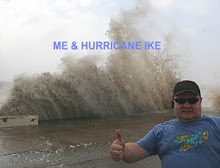ChaserTV & Saturday Dud
 I'm proud to announce that I will be teaming up with ChaserTV for streaming video! It is being headed by Scott Bennett and my homie from Oklahoma Steve Miller. I am impressed with the technological capabilities and am excited about the potential to provide a much better streaming experience. No more dropped video and having to fidget around with reinstating it while on the road.
I'm proud to announce that I will be teaming up with ChaserTV for streaming video! It is being headed by Scott Bennett and my homie from Oklahoma Steve Miller. I am impressed with the technological capabilities and am excited about the potential to provide a much better streaming experience. No more dropped video and having to fidget around with reinstating it while on the road.For those of you watching it, you shouldn't have to refresh the browser either if it drops. In addition, in EVDO areas, the delay time will be a mere few seconds instead of 30 seconds or more. With a strong and solid technical backend with redundant backups and load balancing, the quality of the stream even on busy days should be very reliable and solid. This has been a huge problem in the past with other services.
In addition to all of that, the business model for me as a streamer and the TV stations using it is a smart one which makes sense on many different levels. And most importantly, it's run by folks that I know and trust. That's a huge relief. :-) I will be working on my live chase page over the next couple of weeks to incorporate the new streaming technology. Stay tuned for that. If you want to stream for chasing or spotting, give ChaserTV a try.
Now for tomorrow's "setup".....
As I've been preaching here and elsewhere, the moisture setup for tomorrow continues to look worse with each run. I'm not surprised one bit given that the available moisture in the GOM basin has been pretty thin and remains so. I've learned this lesson the hard way over the years. Bone-dry air at 850mb will mix out surface moisture with daytime heating. Plain and simple. Elation over late night and morning surface dewpoints in the upper 50's and even lower 60's turns to dissapointment as they crater into the 40's and lower 50's by afternoon.
This brings me to CAPE (a measure of potential instability). I always use MLCAPE or Mixed/Mean Layer CAPE. MLCAPE is a much better way of more accurately quantifying instability. Taken from the NOAA website:
MLCAPE
Mean Layer CAPE - CAPE calculated using a parcel consisting of Mean Layer values of temperature and moisture from the lowest 100 mb above ground level.
Since thunderstorms do not ingest ONLY the surface parcel, it only makes sense to use a more representative and realistic parcel. Thus, if you have dry 850mb profiles, your MLCAPE will be much lower than surface based CAPE. (keep in mind that 850mb up on the caprock is lower by a couple of thousand feet than areas further east into Oklahoma and the I-35 corridor thus more susceptable to mixing) In addition, with such a deep dry air profile, storms will have colder downdrafts as a result of evaporative cooling. The result are cold outflow storms that quickly become outflow dominant and updrafts continually undercut. I've had my fair share of chase setups crap out because of this very situation.
Back days ago, I saw just how bad the GOM was smacked from 850mb and above. It is going to take some time to rectify this and build up the 850mb moisture. It may take a few more weeks unless the crystal ball forecast changes drastically. As we saw in 2006, it never really did.
So, all of that just to say that I will be doing other things tomorrow. :-) I'll keep an eye on radar just to see what happens, but I am not anticipating even the thought of chasing it...despite my SDS flaring totally out of control. Besides, I just can't afford any sort of distance chase for another couple of weeks. That makes it easier to be patient until the atmosphere gets better primed.
One optimistic sign is a forecast of some significant rains in the drought-crippled areas of central/southern Texas next week. Hopefully this will be a sign of things to come. Some indications for a change are about day 8 and beyond. Stay tuned!!






0 Comments:
Post a Comment
<< Home